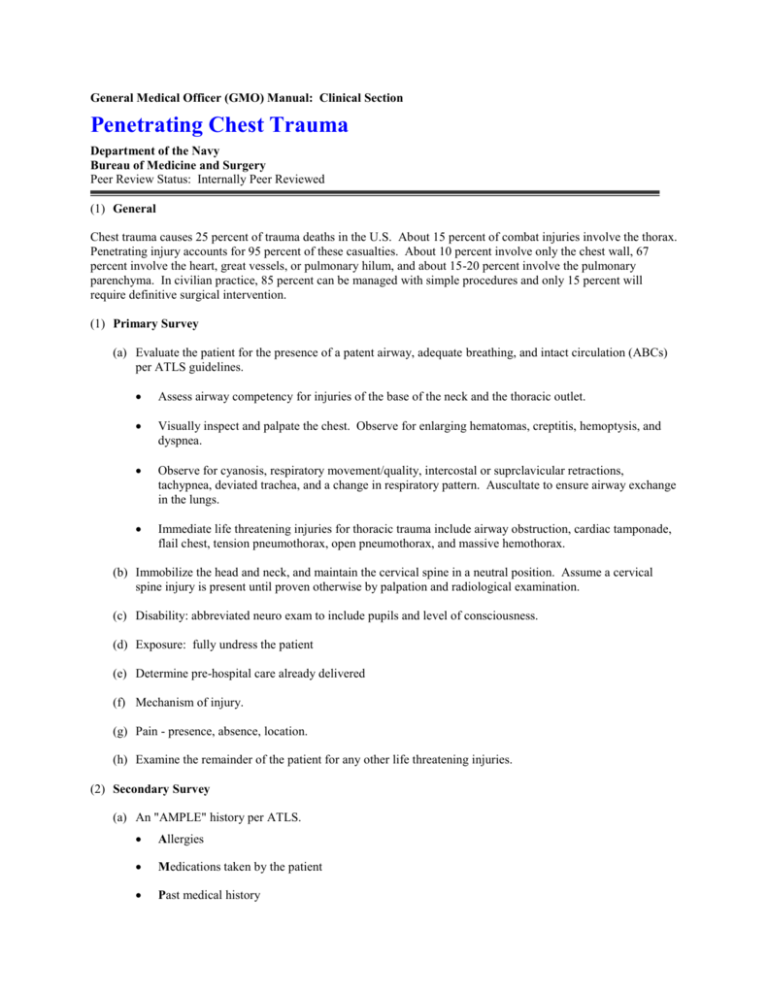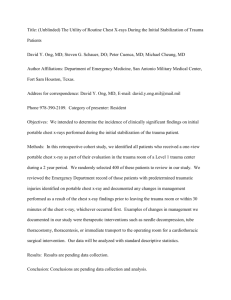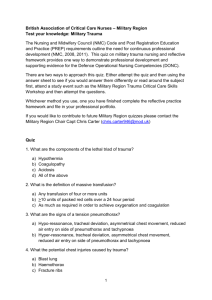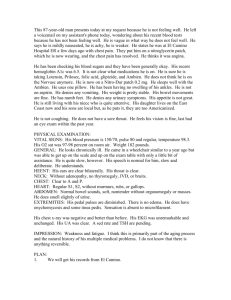General Medical Officer (GMO) Manual: Clinical Section
advertisement

General Medical Officer (GMO) Manual: Clinical Section Penetrating Chest Trauma Department of the Navy Bureau of Medicine and Surgery Peer Review Status: Internally Peer Reviewed (1) General Chest trauma causes 25 percent of trauma deaths in the U.S. About 15 percent of combat injuries involve the thorax. Penetrating injury accounts for 95 percent of these casualties. About 10 percent involve only the chest wall, 67 percent involve the heart, great vessels, or pulmonary hilum, and about 15-20 percent involve the pulmonary parenchyma. In civilian practice, 85 percent can be managed with simple procedures and only 15 percent will require definitive surgical intervention. (1) Primary Survey (a) Evaluate the patient for the presence of a patent airway, adequate breathing, and intact circulation (ABCs) per ATLS guidelines. Assess airway competency for injuries of the base of the neck and the thoracic outlet. Visually inspect and palpate the chest. Observe for enlarging hematomas, creptitis, hemoptysis, and dyspnea. Observe for cyanosis, respiratory movement/quality, intercostal or suprclavicular retractions, tachypnea, deviated trachea, and a change in respiratory pattern. Auscultate to ensure airway exchange in the lungs. Immediate life threatening injuries for thoracic trauma include airway obstruction, cardiac tamponade, flail chest, tension pneumothorax, open pneumothorax, and massive hemothorax. (b) Immobilize the head and neck, and maintain the cervical spine in a neutral position. Assume a cervical spine injury is present until proven otherwise by palpation and radiological examination. (c) Disability: abbreviated neuro exam to include pupils and level of consciousness. (d) Exposure: fully undress the patient (e) Determine pre-hospital care already delivered (f) Mechanism of injury. (g) Pain - presence, absence, location. (h) Examine the remainder of the patient for any other life threatening injuries. (2) Secondary Survey (a) An "AMPLE" history per ATLS. Allergies Medications taken by the patient Past medical history Last meal Environment and events related to patients injury(s) (3) Ancillary tests (a) Chest roentgenogram. Manditory after primary survey Mark entrance and exit wounds with a radiopaque marker May be useful to exclude injury to the thoracic viscera if wounds appear superficial. Essential after an intervention (i.e. chest tube) to document amelioration of injury. Serial chest x-rays at least every 6 hours with penetrating trauma until stable after 24 hours. (b) Hgb/Hct followed sequentially may point to occult bleeding. (c) Pulse oximetry, Cardiac monitor, and an ECG. (d) ABG's (if available) confirm adequacy of oxygenation, ventilation, and shock resuscitation (4) Diagnosis (a) Injuries due to penetrating trauma. (1) Airway obstruction. (2) Tracheobronchial disruption - noisy labored breathing, hemoptysis, subcutaneous emphysema, massive air leak out chest tube. (3) Esophageal rupture - particulate matter in chest tube, mediastinal air, intermittent air leak. (4) Cardiac tamponade - narrowed pulse pressure, distended neck veins, muffled heart sounds, pulsus paradoxus, but no tracheal deviation. (5) Tension pneumothorax - respiratory distress, ipsilateral absence of breath sounds, ipsalateral hyperresonance with percussion, tracheal deviation to the opposite side (late finding), +/- neck vein distension (often absent), and cyanosis (late). (6) Open pneuomothorax (sucking chest wound) – hypoxia results due to chest wall defect (7) Massive hemothorax - shock, absent breath sounds with dullness to percussion, +/- neck vein distension (depending on intravascular volume status). (8) Pulmonary contusion - seen on chest x-ray and may manifest by progressive hypoxia. (9) Traumatic diaphragmatic laceration - suspect on chest x-ray if diaphragm not clear, NG tube curls up into chest, loculated subpulmonic pneumothorax. (5) Treatment and Resuscitation (a) ABCs as per ATLS. (b) Serious penetrating chest injuries (1) Ensure an airway, intubate if necessary. (2) Cover chest wall holes on 3 sides. Do not totally occlude seal because this can lead to a tension pneumothorax. Don't remove impaled, embedded objects. (3) Place a chest tube to remove air and/or blood from the pleural space. Don't insert through an injury site. (4) Start two large bore IV's and administer Ringer's lactate solution and blood as necessary to maintain adequate blood pressure. (5) ABG's if available should be assessed to ensure adequate oxygenation, ventilation, and resuscitation from shock. (6) If cardiac tamponade suspected, perform pericardiocentesis. If tamponade found, leave a plastic catheter in place attached to a stopcock, so reaspiration may be performed prn. (7) Evacuate as a litter patient for surgical evaluation. (8) Place a one-way (Heimlich) valve in line of every chest tube unless a pleuovac or equivalent water seal system can be used. (9) Every such patient requires supplemental oxygen, NG or OG intubation, and a bladder catheter. (c) Minor injuries. Superficial chest wall injuries may be debrided and closed. If no evidence of hemo- or pneumothorax is seen on chest x-ray in 6 hours, and the patient is otherwise asymptomatic, return to duty is indicated. (d) After initial evaluation, emergency management, resuscitation, and stabilization of the casualty with a penetrating thoracic cavity injury, all such injured should be emergently evacuated to a facility with surgical capability. References (a) Wounds and Injuries of the Chest, Chapter XXVIII, Emergency War Surgery, 2nd U.S. Revision, pp. 339–350, 1988. http://www.vnh.org/EWSurg/EWSTOC.html (b) Thoracic Trauma, Chapter 4, Advanced Trauma Life Support for Doctors, Student Course Manual, American College of Surgeons Committee on Trauma, pp. 125-156, 1997. Revised by CDR Lawrence H. Roberts, MC, USN, Trauma Training Coordinator for the Navy, Department of General Surgery, Naval Medical Center San Diego, San Diego, CA (1999).







